The Soviet War Memorial in Treptower Park is the largest of several memorials that were built in Berlin to honor the Red Army soldiers who were killed in the Second World War.
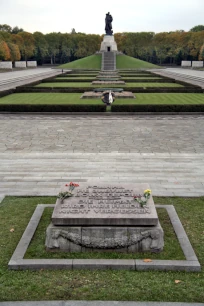
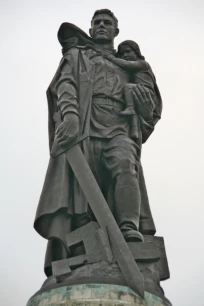
The Great Patriotic War
During the Second World War – known in Russia as ‘The Great Patriotic War’ – the Soviet Union suffered the largest losses of all nations involved, with more than twenty-five million of its people killed. During the battle of Berlin alone, which was fought between April 16 and May 2, 1945, 22,000 Soviet soldiers lost their lives.
To honor these soldiers and to celebrate the Red Army’s victory over Germany, the Soviet military ordered the construction of several memorials. The largest of these was built between 1946 and 1949 in Treptower Park, in southeast Berlin, where more than 7,000 Red Army soldiers were buried.
Construction
A competition organized to design the memorial received thirty-three submissions. An entry by a collaborative group under the lead of architect was selected. The group, led by architect Yakov Belopolski, also consisted of an engineer (Sarra Valerius), a sculptor (Yevgeny Vuchetich) and a painter (Alexander Gorpenko). A site of about ten hectares (25 acres) in the former borough of Treptow was chosen as the location for the memorial.
The bombastic memorial was built under the guidance of the Soviet Army with the help of almost 1,200 German workers. The memorial was officially dedicated on May 8, 1949 (the fourth anniversary of the surrender of the German army), by the Soviet commander in Berlin, Major General Alexander Kotikov.
The Memorial
The memorial was built in typical Stalinist style, with lots of symbolism and patriotic glorification. What the memorial lacks in artistic quality is compensated by sheer monumentalism.
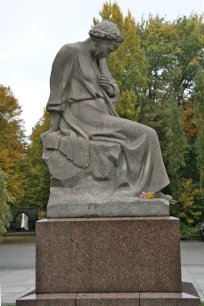
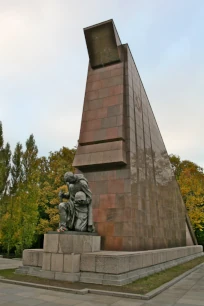
Mother Homeland
Stone arches on two avenues – Pushkinallee and Am Treptower Park – mark the north and south entrance of the memorial site. They lead to an allegorical granite statue of Mother Homeland grieving for her dead children. Mother Homeland personifies the Soviet Union; before 1917 she was known as Mother Russia.
Esplanade
From here, an esplanade lined with weeping birches creates a vista towards the centerpiece of the memorial: a colossal bronze statue of a Soviet soldier, the so-called ‘Big Soldier’. The view is framed by two massive triangular-shaped walls guarded by statues of kneeling soldiers. The walls, engraved with hammer and sickle, symbolize lowered flags. They are made of red marble that is thought to come from the ruins of the New Reich Chancellery. From the end of the esplanade, visitors have a view over the sunken cemetery.
Cemetery
The cemetery is lined with two rows of limestone sarcophagi, sixteen in total. They represent the former republics of the USSR and are decorated with reliefs that depict scenes from the war. Quotes from Stalin are inscribed on the sarcophagi in German and Russian.
Big Soldier
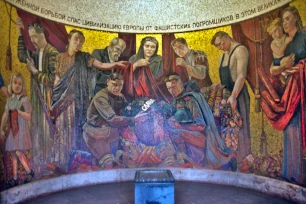
The memorial culminates in a massive heroic monument known as the ‘Big Soldier’. It shows a Soviet soldier holding a rescued child, a symbol of liberation. In his right hand, he holds a sword that rests on a broken swastika. The bronze monument has a height of more than eleven meters (36 ft) and weighs about seventy tons. It was created by Yevgeny Vuchetich and cast in 1949 in Leningrad (now Saint Petersburg), before it was transported in six pieces to Berlin.
The monument rests on a large pedestal that sits at the top of a mound. A staircase up the mound leads to a small crypt that is decorated with a large mosaic, created by the local company of Puhl & Wagner.

